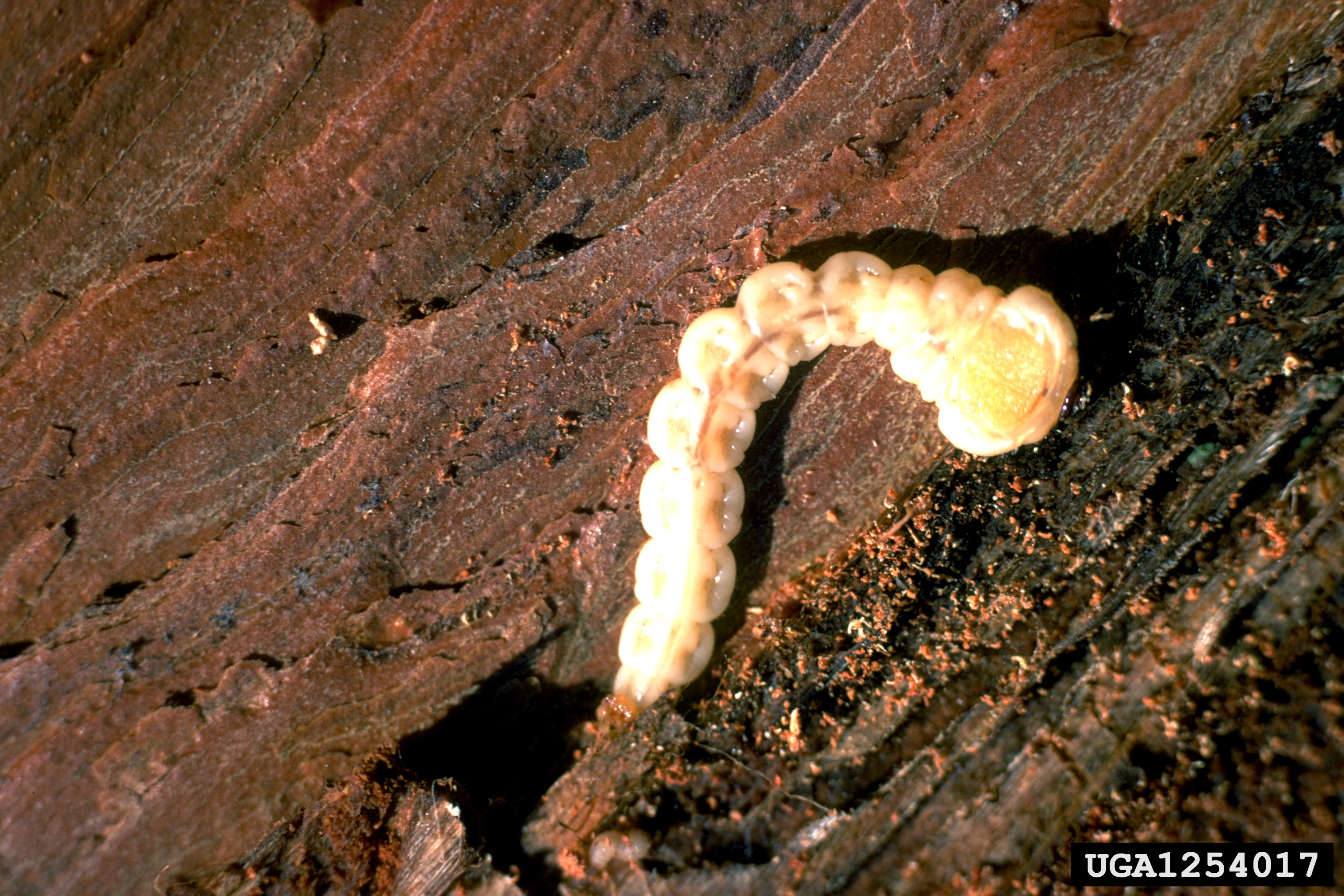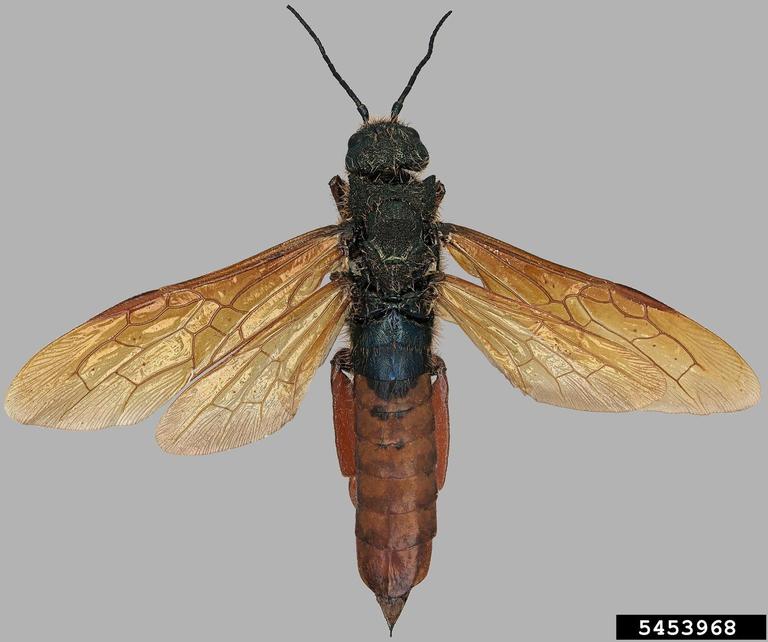 Borers in Landscape Trees - February 6, 2019 Jeff Schalau, Agent, Agriculture & Natural Resources University of Arizona Cooperative Extension, Yavapai County Fast-growing deciduous trees such as cottonwood and willow are sometimes planted in residential landscapes because of their fast growth. These trees typically do well for three to five years, then growth slows and the trees die seven to ten years later. Cottonwood and willows perform best when growing next to a source of fresh water such as a lake, river, stream, or ditch. Most sprinkler or drip irrigated landscapes simply cannot supply the water necessary to support large riparian trees. These stressed trees are then colonized by wood boring insects which hasten their decline. These wood borers are insects that develop underneath the bark of woody plants. Most of these insects can attack only dying trees, felled logs or trees under stress. In our area, the cause of stress is usually lack of irrigation, but stress can also be the result of mechanical injury, root disturbance, sunscald, and diseases. Wood borers colonize these stressed trees and are often blamed for tree mortality. However, the underlying issue is the physiological stress which provided the wood borers with opportunity. Wood borers are usually beetles or moths which develop in the wood as larvae and emerge in one or two years as adult insects. These adult insects emerge with the sole purpose of finding a mate and depositing eggs on another susceptible host tree. Longhorn borers, named for their long antennae, are a common group of wood boring beetles. Their larvae are commonly referred to as roundheaded wood borers which feed deep within the wood and their life cycle may last several years. In Arizona, we have two large species of longhorn beetles. The Palo Verde Borer and the Giant Oak Root Borer. A mature larva of these species is often three inches or more in length. There are many other longhorn beetles which are smaller in size. I have received calls from people building a home using pine logs – a year or so after construction, adult longhorn beetles began to emerge. Most longhorn beetle larvae feed on wood that has already been stressed or killed by other agents. Metallic wood borers are named for their metallic sheen and are often green, bronze, or blue. Their larvae are known as flatheaded wood borers and their galleries have an oblong shape in cross section. Many times, the galleries are packed with frass (insect excrement). They feed on recently killed wood, creating oval-shaped tunnels through the cambium and sapwood. Complete development from egg to adult usually takes one year. Metallic wood borers develop only in dead wood or in drought-stressed trees. Locally, I have seen these insects in dead and dying ponderosa pine and sycamore, but there are many species that occur in various host trees. Horntails (also called wood wasps) are a family of nonstinging wasps that develop solely within trunks and branches of killed or damaged trees. Of greatest concern are horntails that normally are attracted to and complete their life cycles in newly dead or dying conifer trees. Timber salvaged from these trees can be processed into infested lumber. This can lead to adult wasps emerging in recently completed buildings or structures. Wood wasp damage in buildings is more cosmetic than structurally weakening. Although these insects are extremely annoying, they aren’t harmful to humans or structures. They only colonize trees and won’t bore into wood in buildings or furniture. Two or more years are required for the horntails to complete their development. Clearwing moths are also found in our area. These day-flying moths have transparent areas on their wings, a narrow body, and are often striped yellow and black which sometimes allows then to be confused with wasps. The larvae include some insect pests, such as the sequoia pitch moth, ash/lilac borer, peach tree borer, raspberry crown borer, viburnum borer and currant borer. Their life cycle typically requires a year to complete. Of the species discussed in this article, the clear-wing borers are the only insects capable of damaging apparently healthy trees. Most wood boring insects are attracted to dead and dying trees making control unnecessary. When selecting a landscape tree, it is important to select a species suited to your climate, soil, space limitations, and to provide it with appropriate care (primarily irrigation). Photos and additional information are included below. Follow the Backyard Gardener on Twitter – use the link on the BYG website. If you have other gardening questions, call the Master Gardener help line in the Camp Verde office at 928-554-8992 or e-mail us at verdevalleymg@gmail.com and be sure to include your name, address and phone number. Find past Backyard Gardener columns or provide feedback at the Backyard Gardener web site: http://cals.arizona.edu/yavapai/anr/hort/byg/. Photos  An adult and larvae of the California prionus beetle (Prionus californicus) in the laboratory (David Gent, USDA Agricultural Research Service, Bugwood.org).
An adult and larvae of the California prionus beetle (Prionus californicus) in the laboratory (David Gent, USDA Agricultural Research Service, Bugwood.org). Flatheaded wood borer larva in pine (William M. Ciesla, Forest Health Management International, Bugwood.org).
Flatheaded wood borer larva in pine (William M. Ciesla, Forest Health Management International, Bugwood.org). Blue horntail wasp (Sirex cyaneus, Steven Valley, Oregon Department of Agriculture, Bugwood.org).
Blue horntail wasp (Sirex cyaneus, Steven Valley, Oregon Department of Agriculture, Bugwood.org). Western poplar clearwing (Paranthrene robiniae, James Solomon, USDA Forest Service, Bugwood.org ).
Western poplar clearwing (Paranthrene robiniae, James Solomon, USDA Forest Service, Bugwood.org ).Additional Resources Shade Tree Borers Colorado State University Extension extension.colostate.edu/topic-areas/insects/shade-tree-borers-5-530/ Wood Wasps and Horntails University of California Agriculture and Natural Resources ipm.ucanr.edu/PMG/PESTNOTES/pn7407.html Pitch Moths (a species of Clearwing Moth) University of California Agriculture and Natural Resources ipm.ucanr.edu/PMG/PESTNOTES/pn7479.html |